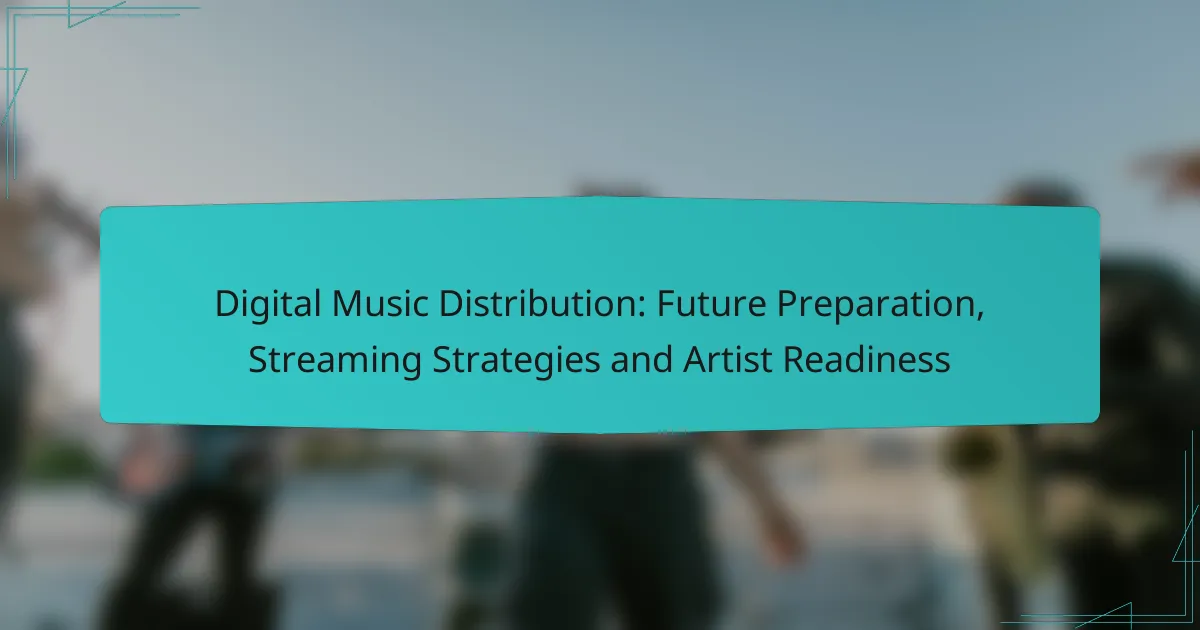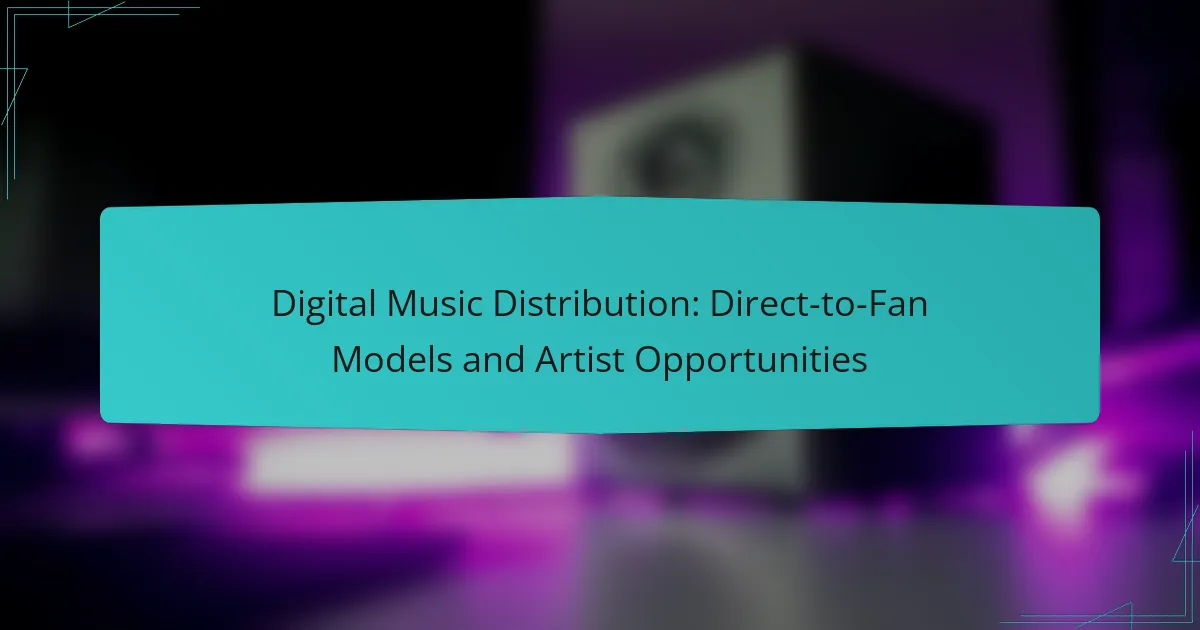The landscape of digital music distribution is rapidly evolving, driven by emerging trends that reshape how artists engage with their audiences and monetize their creations. With the advent of streaming platforms, blockchain technology, and artificial intelligence, musicians are gaining unprecedented control over their work while benefiting from enhanced user experiences and fair compensation models.
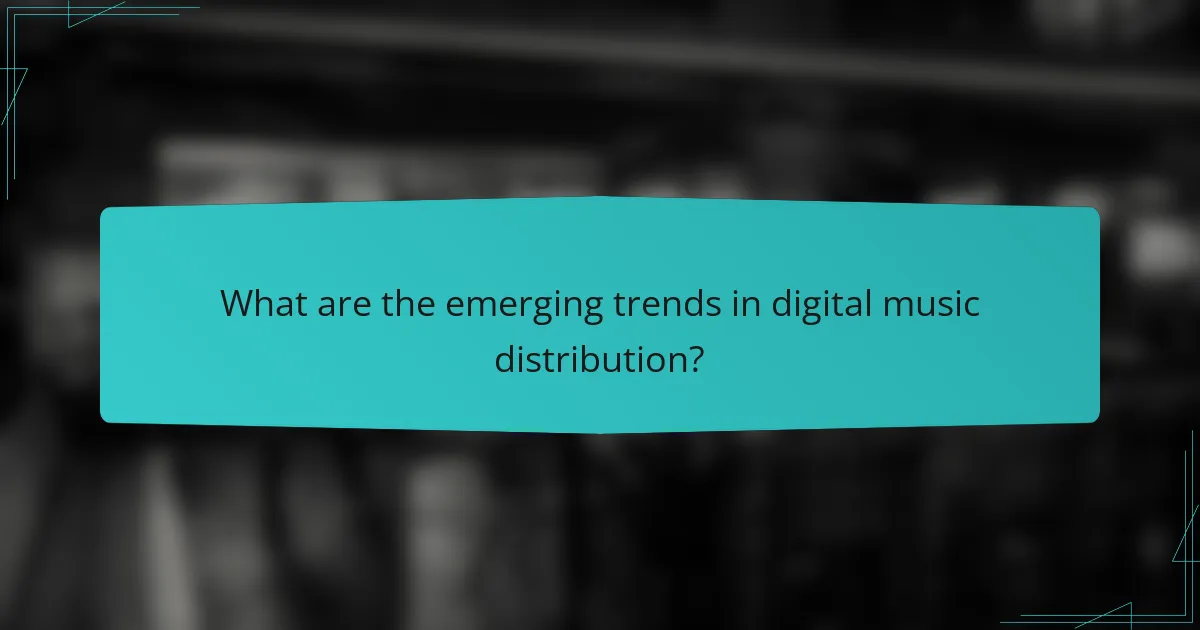
What are the emerging trends in digital music distribution?
Emerging trends in digital music distribution reflect significant shifts in how artists connect with audiences and monetize their work. Key developments include the rise of streaming platforms, direct-to-fan sales, niche services, social media integration, and expanding global markets.
Increased use of streaming platforms
Streaming platforms have become the dominant method for music consumption, with services like Spotify, Apple Music, and YouTube leading the way. These platforms offer vast libraries and personalized playlists, making it easier for listeners to discover new music.
Artists benefit from streaming through exposure and potential revenue, although payouts per stream can be low. It’s crucial for musicians to promote their music effectively on these platforms to maximize their reach.
Growth of direct-to-fan sales
Direct-to-fan sales allow artists to sell music, merchandise, and concert tickets directly to their audience, bypassing traditional distribution channels. This model fosters a closer relationship between artists and fans, often leading to higher profit margins.
Platforms like Bandcamp and Patreon facilitate these sales, enabling artists to retain more control over their earnings. Musicians should consider offering exclusive content or experiences to incentivize purchases directly from them.
Rise of niche music services
Niche music services cater to specific genres or communities, providing tailored experiences that larger platforms may overlook. Examples include services focused on indie music, classical, or regional sounds, which attract dedicated listener bases.
These platforms often offer unique features, such as curated playlists or artist interviews, enhancing user engagement. Artists should explore these services to reach targeted audiences and build a loyal following.
Integration of social media for promotion
Social media plays a crucial role in music promotion, allowing artists to engage with fans and share their work instantly. Platforms like Instagram, TikTok, and Twitter enable musicians to create buzz around new releases and connect with audiences in real-time.
Effective use of social media can amplify an artist’s reach, but it requires consistent content creation and interaction. Musicians should leverage trends and user-generated content to enhance visibility and foster community.
Expansion of global markets
The digital music landscape is increasingly global, with artists reaching audiences beyond their home countries. Streaming services have made it easier for music from various cultures to gain international recognition, leading to diverse musical influences.
Artists should consider localizing their marketing strategies to appeal to different regions, including language adaptations and cultural references. Understanding global trends can help musicians tap into new markets and expand their fan base effectively.
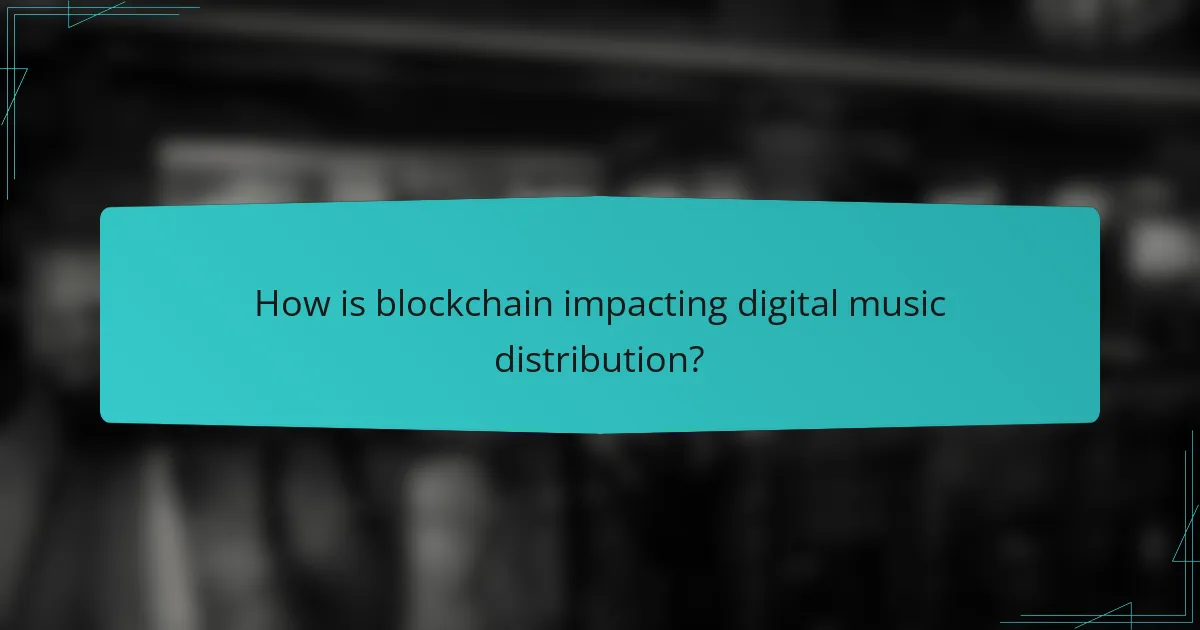
How is blockchain impacting digital music distribution?
Blockchain is transforming digital music distribution by providing a decentralized and transparent framework for managing rights and royalties. This technology enables artists to retain more control over their work while ensuring fair compensation through automated processes.
Enhanced transparency in royalties
Blockchain enhances transparency in royalties by recording every transaction on a public ledger. This allows artists and stakeholders to track how much revenue is generated from their music and how royalties are distributed. As a result, discrepancies in payments can be easily identified and addressed.
For example, if a song is streamed millions of times, blockchain can provide a clear breakdown of how much each party involved—such as the artist, producers, and songwriters—earns from those streams. This level of clarity helps build trust among all parties in the music ecosystem.
Smart contracts for automatic payments
Smart contracts on blockchain platforms facilitate automatic payments to artists and rights holders as soon as their music is consumed. These self-executing contracts eliminate the need for intermediaries, reducing delays and administrative costs associated with traditional payment methods.
For instance, when a listener streams a song, the smart contract can instantly distribute the agreed-upon royalties to the artist’s wallet, ensuring timely compensation. This efficiency can significantly improve cash flow for independent musicians.
Decentralized platforms for artists
Decentralized platforms powered by blockchain allow artists to distribute their music directly to fans without relying on traditional record labels. This model empowers creators by giving them more control over their distribution channels and revenue streams.
Platforms like Audius and Ujo Music enable artists to upload their tracks and set their own pricing, fostering a direct relationship with their audience. This shift can lead to higher earnings for artists, as they can bypass the often hefty fees charged by intermediaries.
Protection against piracy
Blockchain technology offers enhanced protection against piracy by securely recording ownership and usage rights. Each piece of music can be linked to a unique digital fingerprint stored on the blockchain, making it easier to prove ownership and track unauthorized use.
This capability can deter piracy by providing a clear legal framework for enforcement. Artists can take action against unauthorized distributions more effectively, ensuring that their intellectual property is respected and compensated appropriately.
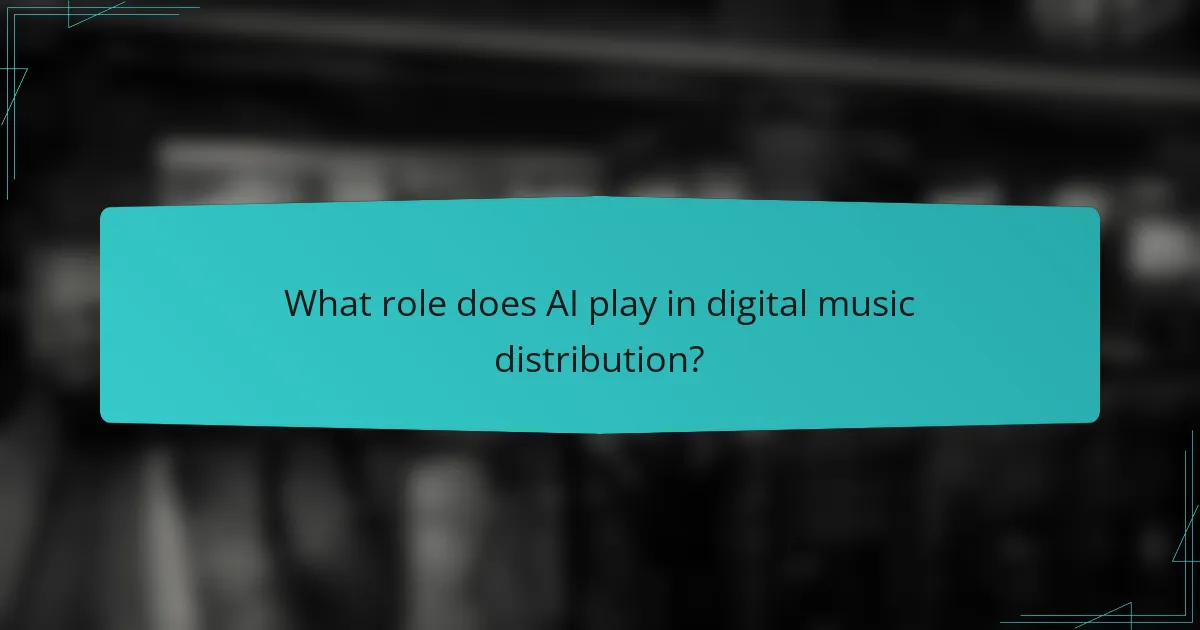
What role does AI play in digital music distribution?
AI significantly enhances digital music distribution by optimizing user experience, personalizing content, and streamlining production processes. Its capabilities range from improving music recommendations to automating content creation, making it a vital tool in the industry.
AI-driven music recommendation systems
AI-driven music recommendation systems analyze user behavior and preferences to suggest songs and artists that align with individual tastes. These systems utilize algorithms that consider listening history, genre preferences, and even social media interactions to curate personalized playlists.
Platforms like Spotify and Apple Music employ these systems to increase user engagement and retention. By continuously learning from user interactions, these recommendations become more accurate over time, enhancing the listener’s experience.
Automated content creation tools
Automated content creation tools leverage AI to generate music, lyrics, and even entire compositions. These tools can assist artists by providing inspiration or creating backing tracks, allowing musicians to focus on more creative aspects of their work.
Examples include platforms like Amper Music and AIVA, which enable users to create original music by selecting parameters such as mood and style. While these tools can speed up the creative process, they may lack the emotional depth that human composers bring to their work.
Data analytics for market trends
AI plays a crucial role in analyzing data to identify market trends in the music industry. By processing vast amounts of streaming data, AI can uncover insights about listener demographics, popular genres, and emerging artists.
Music labels and distributors can use this information to make informed decisions about marketing strategies and artist development. For instance, understanding regional preferences can help in targeting specific audiences effectively, maximizing promotional efforts.
AI in music production and mastering
AI is increasingly used in music production and mastering, offering tools that enhance sound quality and streamline the mixing process. AI algorithms can analyze audio tracks and suggest adjustments to improve clarity and balance, often in a fraction of the time it would take a human engineer.
Software like LANDR utilizes AI to provide automated mastering services, making professional-quality sound accessible to independent artists. While these tools can be beneficial, they should complement, not replace, the expertise of skilled audio engineers who understand the nuances of music production.

What are the criteria for selecting a digital music distributor?
When selecting a digital music distributor, consider factors such as revenue share models, distribution reach, additional services, and ease of use. These criteria will help ensure that your music reaches the right audience while maximizing your earnings and simplifying the distribution process.
Revenue share models
Revenue share models determine how much of your earnings the distributor retains. Most distributors take a percentage of your sales, typically ranging from 10% to 30%, while others may offer flat fees or tiered pricing based on your sales volume. Understanding these models is crucial for evaluating potential profitability.
For example, if a distributor charges a 15% fee and you earn $1,000 from sales, you would receive $850. Compare different models to find one that aligns with your financial goals.
Distribution reach and network
The distribution reach refers to the number of platforms and territories where your music will be available. A distributor with a wide network can help you access major streaming services like Spotify, Apple Music, and Amazon Music, as well as niche platforms.
Consider whether the distributor can also reach international markets, which can significantly expand your audience. Some distributors focus on specific regions, so ensure their reach aligns with your target demographics.
Additional services offered
Many digital music distributors provide additional services that can enhance your music career. These may include marketing tools, royalty collection, analytics, and even licensing opportunities. Look for distributors that offer features like playlist pitching or social media promotion to boost your visibility.
Evaluate whether these services justify any additional costs and how they can support your overall strategy for music promotion and revenue generation.
Ease of use and integration
Ease of use is a critical factor when selecting a digital music distributor. A user-friendly platform can streamline the uploading process, making it simpler to manage your releases and track performance. Look for intuitive dashboards and clear instructions.
Additionally, consider how well the distributor integrates with other tools you may use, such as music production software or social media platforms. Seamless integration can save time and reduce the potential for errors during the distribution process.
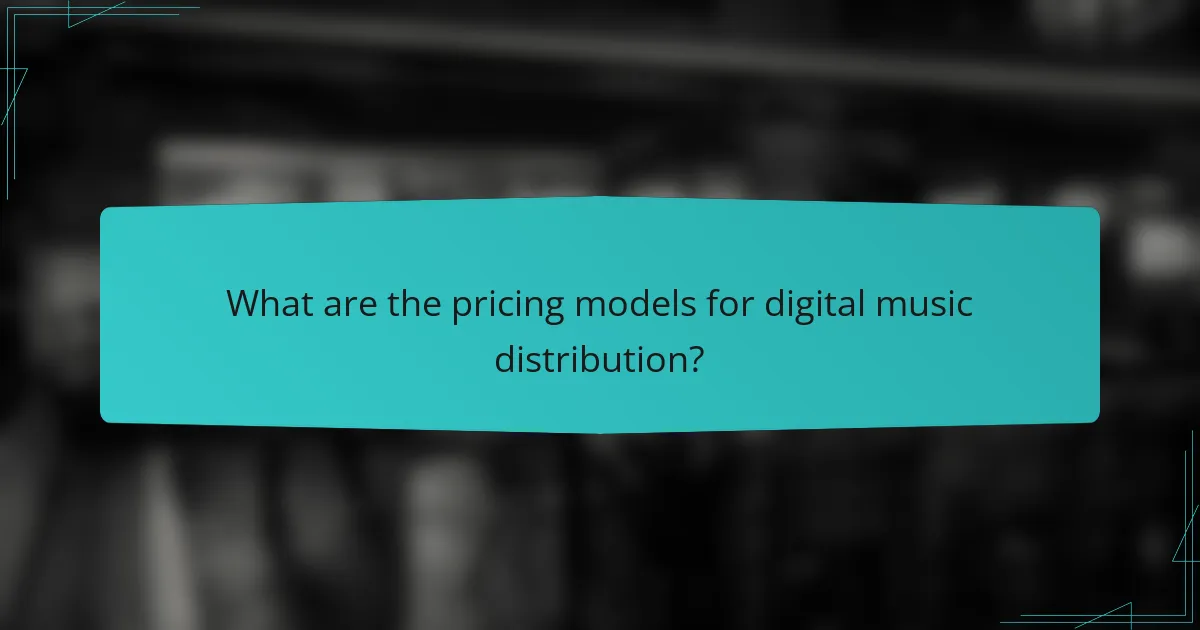
What are the pricing models for digital music distribution?
Digital music distribution pricing models typically include revenue share, flat fees, and hybrid approaches. Each model has its own implications for artists and labels regarding earnings and control over their music.
Revenue Share Model
The revenue share model is one of the most common pricing structures in digital music distribution. In this model, distributors take a percentage of the revenue generated from music sales or streams, which can range from 10% to 30% depending on the service.
Artists should consider the trade-off between upfront costs and ongoing revenue. While this model may require less initial investment, it can significantly reduce overall earnings over time. It’s essential to read the fine print to understand what percentage applies to different types of income.
Flat Fee Model
In a flat fee model, artists pay a set amount to distribute their music, regardless of how much revenue they generate. This fee can vary widely, often ranging from $10 to several hundred dollars annually, depending on the distributor and the services included.
This model is beneficial for artists who expect high sales or streaming numbers, as they retain all revenue after paying the initial fee. However, it can be a risk for those unsure about their music’s market performance, as they must pay upfront without guaranteed returns.
Hybrid Model
The hybrid model combines elements of both revenue share and flat fee structures. Artists may pay a lower flat fee while also agreeing to a smaller percentage of revenue. This model aims to balance risk and reward for both parties.
Choosing a hybrid model can be advantageous for emerging artists who want to limit upfront costs while still benefiting from potential revenue. However, artists should carefully evaluate the terms to ensure they do not end up paying more than necessary as their music gains traction.

